'Miss Ruby,' Bealsville folk artist and farmer, dies
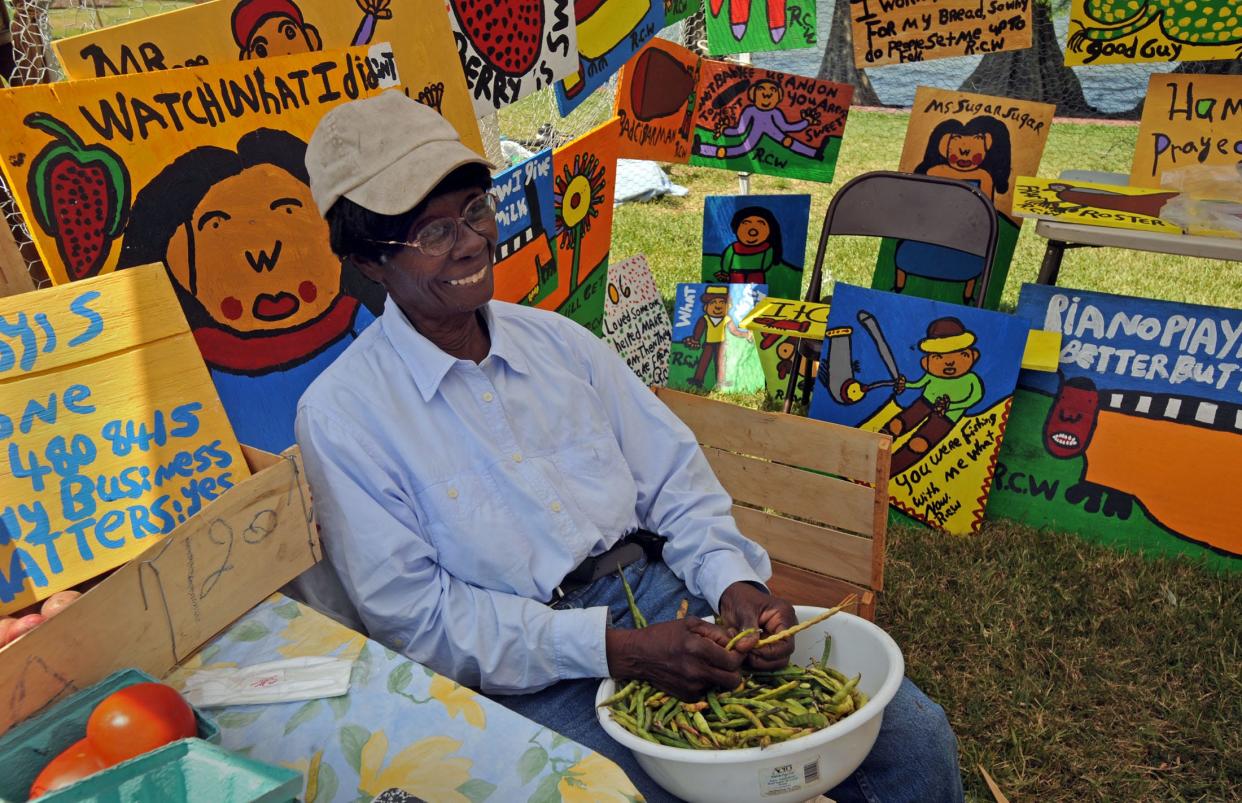
Ruby C. Williams created her own universe on the south side of S.R. 60, conjuring characters as adeptly as she cultivated mustard greens, strawberries and squash. The cast included the impeccably dressed Bonnie Bon Bonnie and her boyfriend, Cleaver, along with piano-toting cows, talking cats and other animals of her own envisioning.
Williams, a self-taught artist who bragged about putting her native hamlet of Bealsville on the map, died Monday, Aug. 8, at an age that remained a carefully concealed secret, though she was apparently in her 90s.
A big heart: Rick Olivo remembered for artistry, generosity
Auguste Rodin on display: Polk Museum opening Rodin exhibition
Williams embraced painting in late middle age as an outgrowth of the signs she had made for years to advertise the produce stand she operated in Bealsville, just across the county line from Polk County in Hillsborough County.
Jeanine Taylor, an art dealer who promoted Williams’ work at her Sanford gallery, recalled that decades ago a Miami gallery owner noticed Williams’ stand while driving past on S.R. 60. Recognizing the artist of the hand-painted signs, such as a single strawberry against a bright yellow background, the dealer stopped in and offered to buy some of the displays.
Before long, the man returned to buy more of Williams’ signs. Taylor said Williams grew perturbed about the need to paint replacement signs.
“So she got mad, and the then one of the next things she painted was, she said, ‘I painted the fiercest thing I could think of,’ and that was an alligator,” Taylor said.
The reptile, which would become one of Taylor’s signature motifs, stretched with its mouth open and teeth exposed, surrounded by the printed phrase: “Tired of being the good guy.”
“She didn't let people run over her,” Taylor said. “Some people said she was testy. I say she was just strong willed and looked out after herself.”
However irksome Williams initially found the sign buyer to be, she soon realized she could supplement her produce business by making and selling artwork. Thus emerged what she labeled on a large, hand-painted sign, “Ruby’s Produce and Art Gallery.”
From Bealsville to D.C.
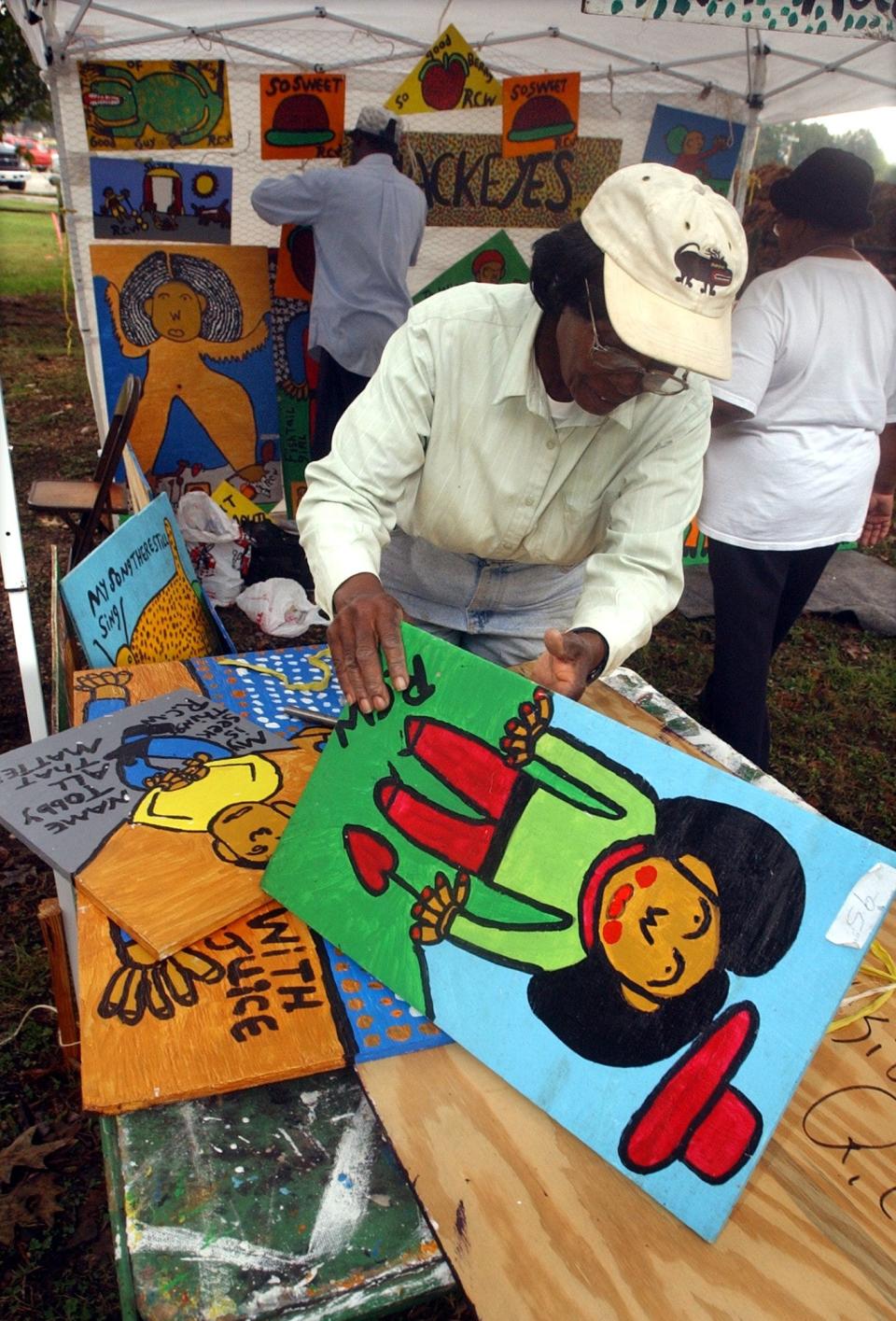
Williams became a farmer/painter in the early 1980s but didn’t start displaying her work until the early 1990s, after receiving encouragement from another folk artist, Rodney Hardee, after he visited her produce stand. Hardee introduced her to photographer Bud Lee, who arranged Williams’ first gallery showing in Plant City, The Ledger has reported.
Williams’ paintings would later be displayed at the Smithsonian Anacostia Community Museum in Washington, D.C. Her simple works, usually painted on plywood, have sold for as much as $65,000 she told a Ledger reporter in 2012.
Her cousin, Precious C. Baker of Lakeland, said she knows of someone in London who bought one of Williams’ paintings.
Williams, known as “Miss Ruby,” lived her entire life on the family property in Bealsville, a rural enclave founded by people freed from slavery. She learned to farm from her parents and as an adult cultivated a range of crops — such as sweet potatoes, peppers and three types of greens — that she sold from the rustic stand along the highway between Brandon and Mulberry.
The artist’s approach was rudimentary. She used unmixed acrylic paint that she squeezed from tubes directly onto wood and then spread with large brushes. The effect, though, inspired appreciation among academics and art professionals, who in recent decades have embraced what is variously called folk art, naïve art and outsider art, work produced by untrained artists using simple materials.
Williams’ paintings generate a range of potential descriptors: buoyant, immediate, whimsical, charming, humorous, vivid, unpretentious, audacious, sly and joyous.
More: Polk Museum of Art announces Mayfaire by-the-Lake winners
Among her repeated motifs, one of the most popular was a rendering of a cow with piano keys covering its back and the printed phrase: “Piano Playing Cow. I Give Better Buttermilk.” Taylor said the idea for that one arose one day as Williams gazed into a pasture across the highway from her property.
“I just get such a kick out of these,” Taylor said. “I mean, her imagination ran wild and everybody loved it. They’d say, ‘Well why do you name it ‘Piano Playing Cow?’ And she’d say, ‘Because that's what I thought up.'”
Williams came to recognize the value of her art. She posted a sign warning, “Don’t Take Photos” at her produce stand, where she customarily wore a white cap with “Artist Ruby RCW” painted on the front.
Remembered as visionary
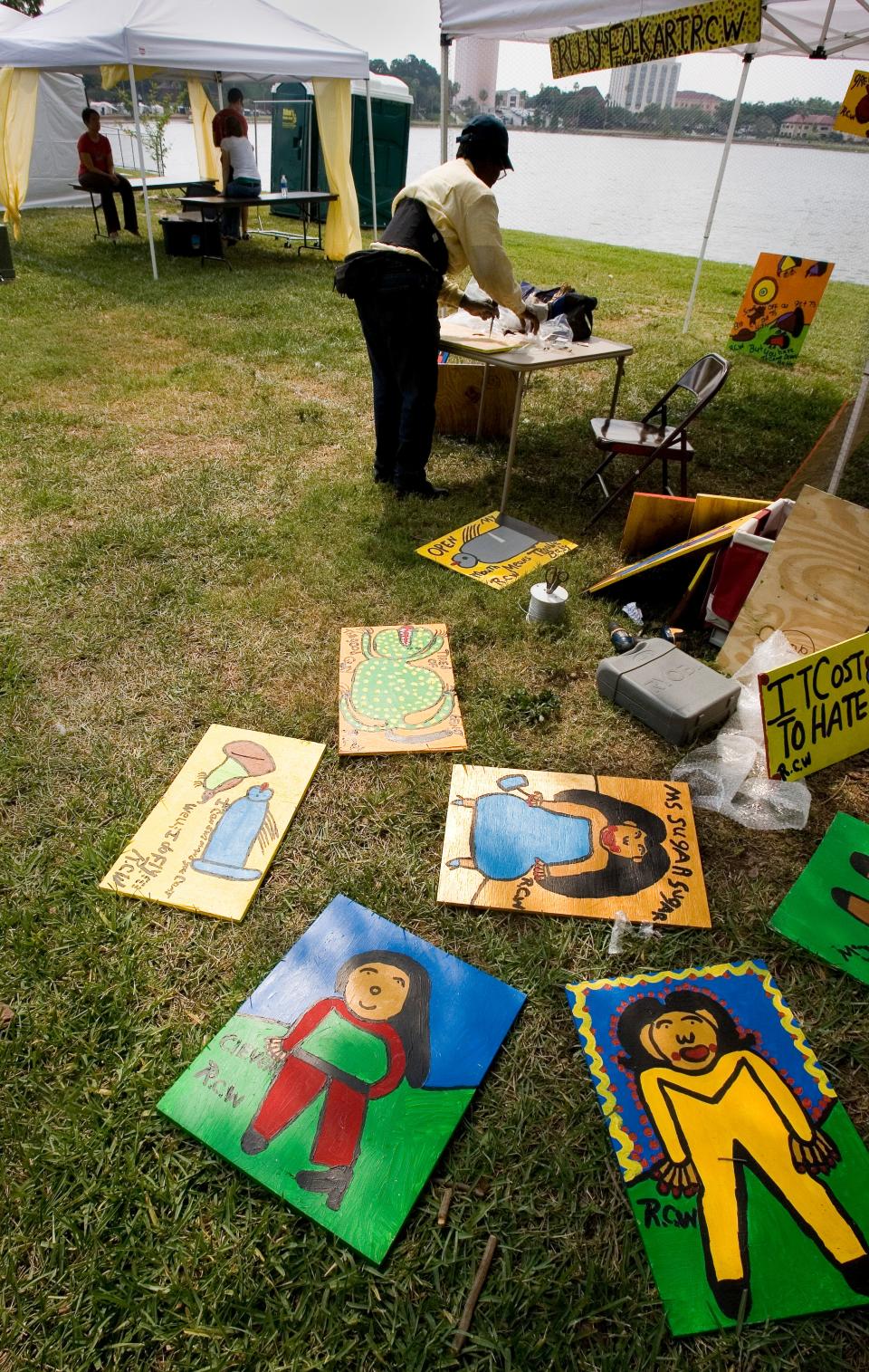
Baker grew up in Lakeland and often visited her grandmother, who lived down the road from the Williams property.
“She was quite a — I don’t even know the word to say, but an interesting lady,” Baker said. “She was very outgoing. Cousin Ruby just illuminated with adventure. She was a sightseer. Like, she could see things.”
Baker has one of Williams’ paintings displayed in her Lakeland home. It depicts a boy wearing a baseball glove on one hand and holding a racquet in the other, with the phrase, “Learn To Work Also. Hm. Hm.”
“Every painting she did had a meaning behind it,” Baker said. “And she would paint as it would come to her heart and was a beautiful folk artist, just wonderful. And the price you paid for her work was worthy of, you know, what she had painted.”
The Polk Museum of Art in Lakeland owns some of Williams’ work and has exhibited her paintings in various shows. For years, the artist was a regular presence at the Mayfaire-by-the-Lake art show that the museum organizes.
As Baker recalled, Williams operated on the honor system at her stand when she wasn’t there.
“She was so faithful to trust people to come and buy her vegetables that she would leave a tin can out front when she was not there for you to put your money in that can and make your own change and get the bunch of greens or sweet potatoes or whatever was in season,” Baker said. “You’d pick your vegetables but you left your money in the can. I thought, ‘That’s a very trusting heart.’”
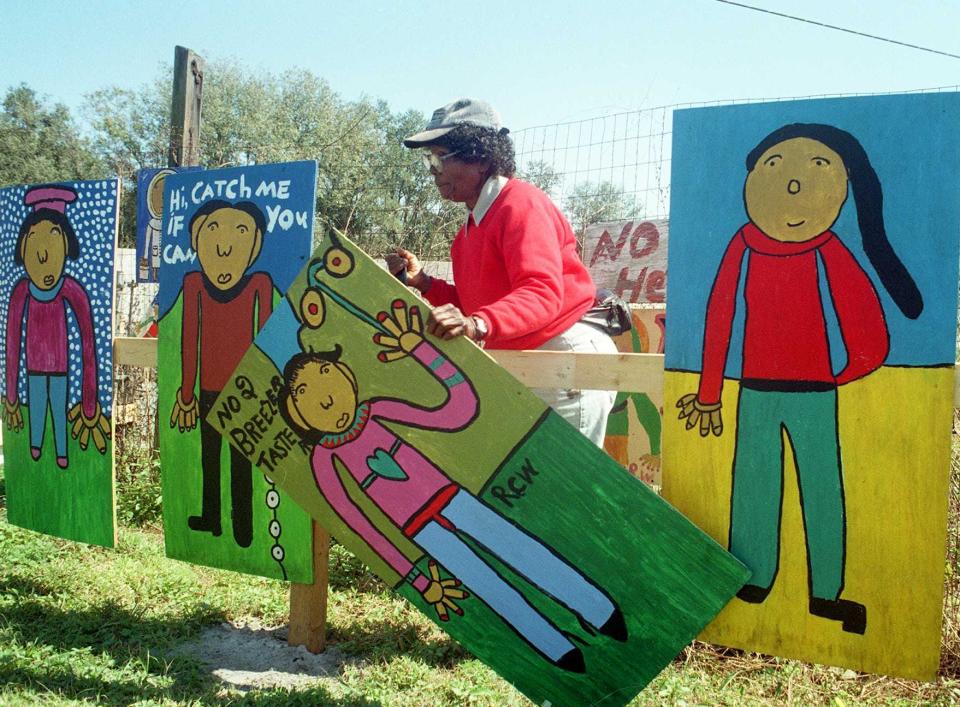
'Doc left us better than he found us': Mourners gave their final farewells to 'kingmaker'
Vintage, boho and eclectic: Central Florida women debut a joint art collection
Kathy Gibson, a St. Petersburg resident who grew up in Lake Wales, said she met Williams at her property about 25 years ago. Gibson is an independent curator and art consultant, helping to place works into businesses and homes, and she often hosted events at her home to introduce potential buyers to Williams. The art usually brought samples of her crops to supplement the paintings hung on Gibson’s walls.
“Often when people would come to my house and they’d meet her or they’d buy a piece of her art, then they would go out to her stand because they did want to learn more about her and be in her environment,” Gibson said. “And it just was kind of an adventure to be there because she was just so funny and wise and spiritual. And you’d always learn things when you were with her.”
Gibson, the daughter of Lake Wales City Commissioner Robin Gibson, helped arrange an exhibit of Williams’ work at a Hillsborough Community College campus in 2013. She also participated in a conversation with Williams recorded in Sarasota for StoryCorps, a non-profit organization that preserves interviews sometimes aired on NPR stations.
Gibson owns a few of Williams’ pieces. One is a dramatically horizontal sign merely bearing the hand-lettered phrase, “Wait on the Lord.” Gibson recalled once noticing that a chicken in one of Williams’ paintings had a “little tag” sticking up from its body.
She asked what the thing was, and Williams replied that chickens don’t have arms and therefore need something to hold their purses in place.
Taylor, the gallery owner who represented Williams, escorted her in 2005 to the State Capitol in Tallahassee, where Williams received a Florida Folk Heritage Award. Four years later, Williams collected an Award of Distinction from the Folk Art Society of America.
For more than two decades, Williams hosted a harvest celebration gathering for family and friends on the first Saturday of November. Williams and her relatives prepared a feast that included ribs, cornbread, greens and potato salad, Baker recalled.
Gibson attended many of those gatherings, which she said continued until the pandemic. The events gave Williams a chance to preach, something she had done throughout her life. Many of her paintings contain references to God or biblical allusions.
“She always said she was going to preach first and we’d get to eat after that,” Gibson said. “And then she’d say, ‘Goodbye, art,’ because she was selling art, showing art and preaching. But she was always about preaching first.”
‘A million’ paintings
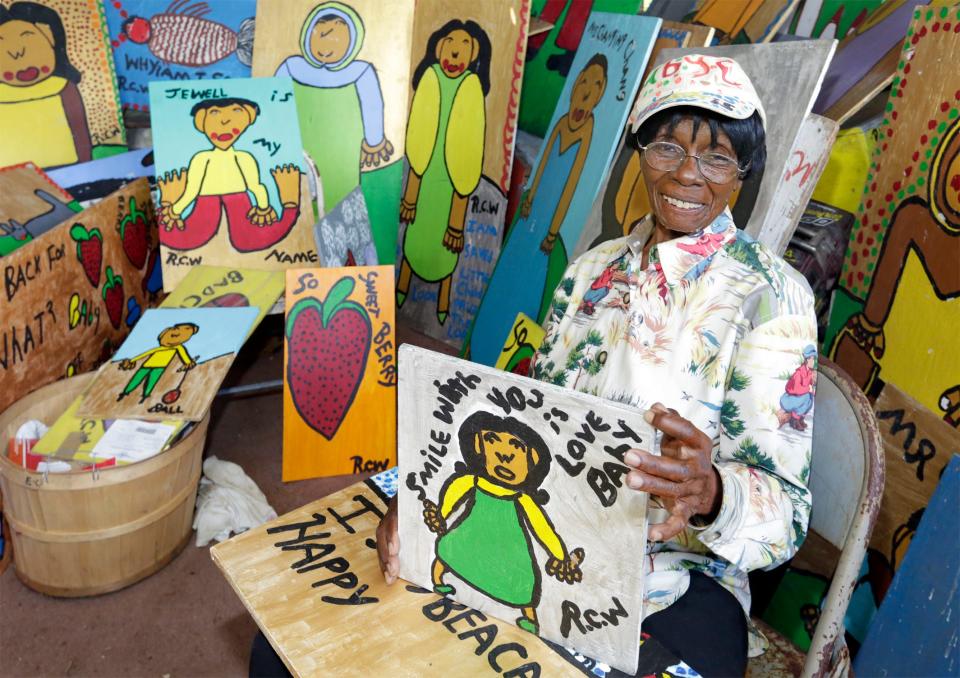
Williams co-authored “I Am Ruby,” an autobiographical children’s book full of her illustrations, with Sylvia McCardell-Thomasson.
Williams was more comfortable speaking to children in classrooms than to artistic types in galleries, friends said. Taylor sometimes accompanied Williams on excursions to schools.
“She’d come in and she’d have boards all cut for the children,” Taylor said. “And she talked about her artwork, and they really could relate to her because it was kind of primary — primary colors, no mixing, no blending of the colors.”
In 2012, Williams visited a class at Janie Howard Wilson Elementary School in Lake Wales, bringing along some of her paintings, including one of a boy carrying a green sack labeled “Bag Full of Love.”
When a student asked how many paintings she had made, Williams answered, “A million.”
One number Williams kept closely concealed was her age. When Taylor posted about Williams’ death on her newsletter, she gave the artist’s age as 92. She soon received a text from an associate saying Williams was actually 96, and another claimed she was 94, Taylor recalled with a laugh.
“And here’s the reason she said, ‘I don’t want to tell anybody my age — because I want them to buy my art now,’” Taylor said. “And if I tell them my age, they’ll wait until I’m older.’ That was her reasoning.”
Williams gave a different explanation when denying a reporter’s request for her age during the visit to the school in Lake Wales.
“I’m famous now,” she said. “I can say, ‘No.’ That’s one of the last things I’ve got left.”
Williams is survived by a son and many grandchildren, Baker said. Williams had a daughter who died about a decade ago. Reached by phone, the artist’s son said he was too upset to speak.
A funeral service is planned for Saturday at St. Mary Missionary Baptist Church, 1840 E. S.R. 60, in Plant City. A public viewing will take place at 10 a.m., followed by a funeral service at 11 a.m. Face masks are required at all services.
An interment will follow at Pinehill Cemetery, 2601 Sam Hicks Road, in Plant City. Donations of flowers, acknowledgements and resolutions should be directed to Charlow Funeral Home at 813-752-2477.
Gary White can be reached at gary.white@theledger.com or 863-802-7518. Follow on Twitter @garywhite13.
This article originally appeared on The Ledger: Bealsville folk artist and farmer, 'Miss Ruby,' dies

